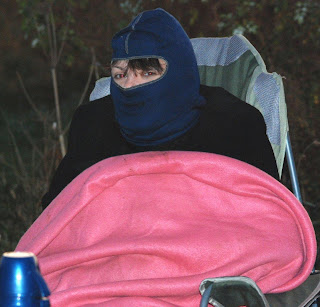With the absence of a ringing blog for the last two weeks you might think that we have not been busy at Stanford. Far from it, we have had several ringing sessions there resulting in 600 birds being processed but yours truly has been tardy in writing them up so here is a quick resume to get us back on track.
Thursday13th October
Masai Mick, Webmaster and I arrived pre-dawn to a damp, dull, still and overcast Stanford. The dampness in the air quickly went but the overcast conditions remained all morning and were in fact ideal ringing conditions. We managed 137 new birds (and 30 retraps). The new birds of note were 3 Blackcaps, 23 Tree Sparrows, 14 Lesser Redpolls and 17 Reed Bunting.
We also controlled a colour ringed Tree Sparrow TR27180
 |
| Control TR 27180 |
 |
| Control TR 27180 |
 |
| Lesser Redpoll |
Friday 14th
The two Micks had a good session with 83 new (9 retraps), ringing our first Redwings (4) of the year, another Blackcap, 7 Tree Sparrows, 29 Greenfinches, 4 Lesser Redpolls, 5 Reed Buntings and a Yellowhammer (our fourth this year of a species that is now all too infrequent at this site)
Saturday 15th
A cold morning with a touch of ground frost meant that some of the new trainees experienced their first cold conditions such that the conversation quickly turned to hot water bottles, hand warmers and other such devices – I am sure trainees used to be made of sterner stuff! A good morning’s ringing with 95 new birds which included 2 Redwing, 2 Goldcrests, 14 Tree Sparrows, 35 Greenfinches, 5 Lesser Redpolls, 4 Reed Buntings and another Yellowhammer (and 25 retraps)
 |
| Cold Trainee # 1 |
 |
| Cold Trainee # 2 |
 |
| Redwing |
 |
| Yellowhammer |
 |
| male Goldcrest |
Monday 17th
The two Micks had a reasonable session as Masai Mick recalls:
Ringing on Monday was quite subdued with only 68 birds caught, of these 54 were new ringed. But it was also a day of celebration as we hit a significant total of 5000 new ringed birds for the year (at Stanford) and of these roughly half have been warblers, so come on you ringers around the country get catching them. Recently we have been catching good numbers of Greenfinch and Goldfinch with some Lesser Redpoll interspersed, which is not a very usual occurrence for us. Redwing and Fieldfare have just turned up over the last week or so and we are hoping to emulate last year’s sterling efforts with another 800+ thrushes this year, weather willing and an understanding wife!!!!
Thursday 20th
Another 54 new birds today (12 retraps) included a single Redwing, 8 Tree Sparrows, 6 Greenfinches, 16 Lesser Redpoll and surprisingly two Pied Wagtails - the three ringed this year are the first at Stanford since 1993.
 |
| Pied Wagtail |
 |
| male Lesser Redpoll |
 |
| another fine male |
Saturday 22nd
68 new birds (23 retraps) were more of the same really, but never boring – 1 Redwing, another Blackcap (that’s 706 this year), 13 Tree Sparrows, 22 Greenfinch, 6 Goldfinch, 1 Linnet, 2 Reed Buntings (making 280 this year), and 8 Lesser Redpolls.
One of the Redpolls was a “Goldenpoll” and is described by Mike Alibone on his blog here
The totals for the period:
 |
| 13th to 22nd October Totals |















